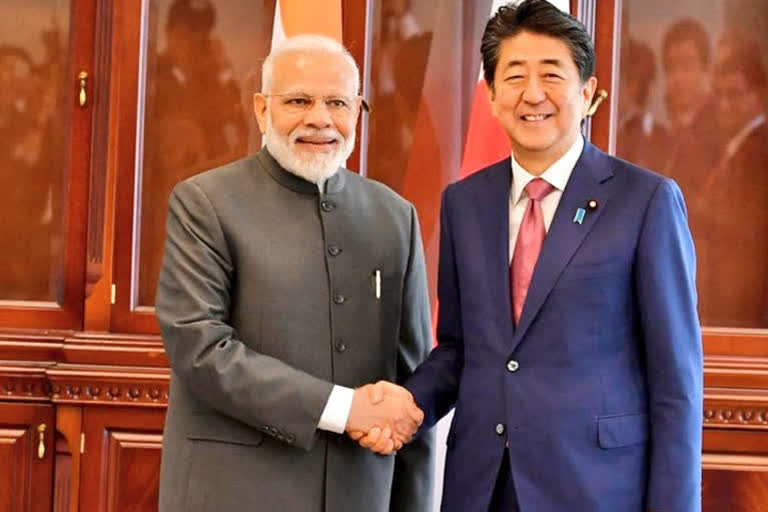New Delhi: With Shinzo Abe announcing his resignation as Prime Minister of Japan, that country again faces a period of political instability while India stands to lose one of its most vocal champions in the global arena. Abe had personally invested in getting the India relationship to centre stage in Japanese policy.
While the foundation for the improving “Global Partnership between Japan and India” was laid in 2001, and annual bilateral summits were agreed upon from 2005, Abe accelerated the pace. During his first tenure, he visited India and addressed the Indian Parliament in August 2007, clearly outlining his vision for the relationship in his “Confluence of the Two Seas” speech, spelling out his concept of the Indo-Pacific, now a crucial pillar of India-Japan relations. Since his second tenure from 2012 he has visited India thrice, including as chief guest for the Republic Day celebrations, and established a close personal bond with the Indian prime minister.
For both Abe and Narendra Modi, the friendship might appear unusual, given that the former is the closest inheritor of political royalty possible in Japan (distinct from the ancient lineage of Japan’s Chrysanthemum throne monarchy) – Abe’s grandfather Nobusuke Kishi was prime minister (1957-60), his father Shintaro Abe was Foreign Minister and he has overtaken his great-uncle Eisaku Sato to become Japan’s longest-serving PM – while Modi has risen from humble beginnings. Their strong nationalist outlooks, shared vision of “stronger” nationhood and Abe’s gradual move to take Japanese capital out of China has not just spawned an increasing convergence of national interests, but also their personal bond, apparent from Abe hosting Modi at his ancestral home in Yamanashi, the first foreign leader to receive the honour.
On the foreign policy front, Abe managed to stay on the right side of Japan’s major ally, the USA, led by a mercurial Donald Trump, while standing firm against an increasingly powerful and assertive China by reaching out, among others, to India and launching, with it, the Asia Africa Growth Corridor as an alternative model to the Chinese Belt and Road Initiative. He has also been the prime mover in bringing together the ‘Quad,’ or the quadrilateral of democracies including, besides Japan and India, the US and Australia, as a clear though unstated signal to China that its assertive policies in the region were irksome.
Despite his global acceptability, Abe has not been able to enthuse popular support within Japan, particularly for his more nationalist policies and efforts to rework the country’s Constitution and revise history, particularly Japan’s colonial history and the Japanese armed forces’ role in wartime exploitation, violence and slavery of ‘comfort women’ in Korea. As his government’s recent White Paper on Defence showed, he has strengthened Japan’s Self-Defence forces to optimum levels.
With India, as the relationship has improved, the 2+2 foreign and defence ministerial meeting initiative has taken off, beginning November 2019, indicating the closest level of bilateral strategic engagement. Both countries signed a transfer of defence equipment and technology pact in 2015, unusual for pacifist post-War Japan, and are negotiating a military logistics support pact: Acquisition and Cross-Servicing Agreement.
Modi and Abe have upgraded bilateral ties to a “Special Strategic and Global Partnership.” Japan, the only country to have suffered a nuclear attack, has signed a seminal civil nuclear energy pact with India, a non-NPT nation, and the relationship now encompasses issues from civilian nuclear energy, counter-terrorism, defence to maritime security, bullet trains to quality infrastructure, including in third countries, to Indo-Pacific strategy. India’s Northeast is another focus area, under the Act East Forum, with large Japanese investments committed.
Abe has pushed to raise representation for the Quad to the foreign ministerial level, as Chinese assertiveness has increased in the Indo-Pacific maritime space and, during the India-China border standoffs, at Doklam in 2017 and earlier this year in Ladakh, Japan has backed India, publicly criticising Chinese behaviour and efforts to unilaterally change the status quo. However, Tokyo has never commented on Indian domestic issues, including Jammu and Kashmir and the Citizenship Amendment Act, the agitation against which forced Abe to cancel his December 2019 visit to Guwahati.
The 66-year-old Abe, Japan’s longest-serving prime minister, apologised to the Japanese people for tasks he said have remained unfinished while he announced he was stepping down for health reasons, a year ahead of the scheduled end of his tenure, in September 2021. He could, instead, have cited his achievements, including what is commonly known as ‘Abenomics,’ his brand of economic policy-making, that focussed on Japan’s economic revival and stabilised the Japanese economy while spurring domestic demand and pulled it out of the quagmire of stagflation that had beset it.
Abe’s sudden resignation will spur some upheaval within his Liberal Democratic Party. His elected successor will serve out the rest of the term, till September 2021, before fresh national elections must be held. Whether his successor will retain the warmth and depth of the focus of relations with India remains to be seen, but New Delhi will be watching forthcoming political developments in Tokyo with major interest.



